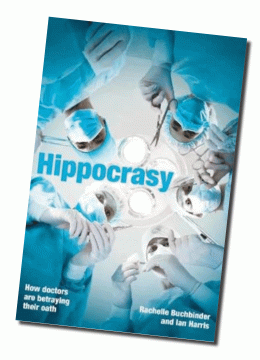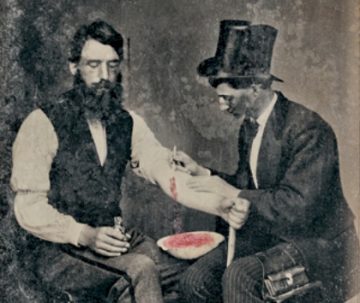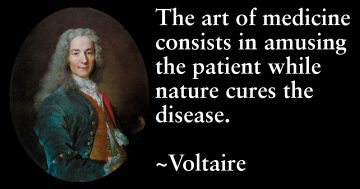COLUMN. Care is increasingly driven by patient demand rather than medical needs, leading to overdiagnosis and overtreatment. Henrik Sjövall has read the book Hippocrasy and asks “What would old Hippocrates have said?”
It is always far nicer to say “yes” than to say “no”. Political currents and the emergence of the internet are driving us toward demand-driven rather than need-driven care. The patient has become a sort of customer who feels entitled to demand a decent level of service. As a rule, we handle this by complying with the patient’s request for referral or through the Swedish art of queuing, even though we sometimes doubt that the patient will gain any benefit at all. It is hard to say no, and if we do, the patient may very often switch to another doctor.

I have just read a very intriguing book, Hippocrasy, written by two highly qualified Australian epidemiologists, Rachelle Buchbinder and Ian Harris. They both have in-depth understanding of clinical trial methodology and solid clinical experience. Buchbinder is a rheumatologist and Harris an orthopedic surgeon. They know what they are talking about.
The book is very well-written and focuses on the Hippocratic Oath, to which we are all expected to adhere. Each chapter begins with a quote attributed to Hippocrates with varying degrees of certainty. For example: “Whenever a doctor cannot do good, he must keep from doing harm.”
Among the chapters are “First, do no harm”, “Science Matters”, “Overtreatment”, and “Treating the problem”, which discusses medicine as big business. Each chapter has real life examples that illustrate and confirm the veracity of what is being discussed. One basic problem they point to is that doctors who order examinations or treatments do not, as a rule, pass on their own doubts to patients, which is in fact contrary to our duty to provide information.
The authors begin with some horrible examples from history: bloodletting, hysterectomy based on the diagnosis of hysteria, and lobotomies based on various psychiatric indications. And even though many doctors were certain to feel that those treatments were of little benefit, they continued to be used.

The example of bloodletting: In 1816, a surgeon, A.L. Hamilton, conducted a small cross-sectional study of 366 patients. The mortality rate of those bled was 10 times higher. And yet it took almost 100 years before the practice was abolished. For example, as recently as 1920, a thick medical textbook proposed its use in some cases of eclampsia. [Eclampsia is a serious obstetric condition that can develop from sepsis (pre-eclampsia), ed.]. And for those who want more examples from women’s health care, I recommend Karin Johannisson’s book Den Mörka Kontinenten [The Dark Continent], about how attempts were made to surgically remove or lock up whatever was not understood.

A slightly less dramatic, but equally disturbing, modern experience: In 2010 we conducted an HTA study on the benefit to patients of removing asymptomatic non-erupted wisdom teeth. We found no support whatsoever for patient benefit, but the intervention was not entirely harmless. We even found reports of individual deaths. And when we discussed the project with our oral surgeons, they said: “Surely this can’t still be going on?!”
It is, and quite widely.
On the pharmaceutical side, the authors of Hippocrasy discuss the examples of Thalidomide and the over-consumption of opiates in the USA. In both cases, the use of sliding indications and active marketing contributed to the extent of the damage, a marketing which, at least in the case of opiates, was eagerly encouraged by doctors with financial links to the pharmaceutical industry.
Patients generally believe that, as long as they receive a diagnosis, they will get treatment and regain their health
Another aspect addressed by the authors is the potential benefit of giving a patient a diagnosis. Patients generally believe that, as long as they receive a diagnosis, they will get treatment and regain their health. What they do not understand, however, is that a diagnosis is often just a name and number for a group of symptoms for which there is no effective treatment. Should we tell the patient that?

Hippocrates: ”I will not be ashamed to say I know not. To do nothing is sometimes also a good remedy”.
Next misconception: We think that patients always want to be prescribed medication. This is wrong, what they actually want is credible reassurance. And the very essence of medical treatment is giving credible reassurance. This requires not only solid understanding, but also an ability to listen to the patient’s own story.
A diagnosis that is just a code for a group of symptoms will not be reassuring in the age of Google. An example of how difficult this can be is IBS, Irritable Bowel Syndrome. The diagnosis is based on the combination of symptoms and the absence of any other medical explanation, and the relevant profile for the symptoms has been revised repeatedly (“Rome I-IV”). Some patients feel a sense of security in knowing that others share similar problems; for others it can directly negatively impact their quality of life and serve as the pole around which their poor quality of life will revolve.
Perhaps, instead, you should say: “This is so common that you can almost say that it is normal. You’ll just have to learn to live with your sensitive stomach.”
Problems with using vague symptoms to diagnose lots of children

Another even more controversial example: ADHD. There is certainly a group of children who benefit greatly from personal support and/or medication, but there are also problems with diagnosing lots of children based on vague symptoms. A few years ago, I heard a talk by Christopher Gillberg, in which he presented a chart showing how autism diagnoses exploded in Stockholm when they became necessary for parents to receive extra support for their “difficult” children. When that rule was eliminated, diagnoses immediately reverted to their previous baseline level. According to Christopher, the real prevalence of ADHD/autism spectrum disorders is just under 5 percent and is very stable over time.
Dare to reconsider!
Not only should you avoid overdiagnosing, you should also dare to revisit previous diagnoses. For example, there is a serious bowel disease called Crohn’s disease that may present in very different ways in different patients. In the past, many people had surgery, but medication now offers good outcomes. Sometimes I saw patients with relatively mild symptoms and basically normal blood samples, where I felt the whole thing did not look right. In some cases, the diagnosis was based on an old intestinal X-ray. When I pulled out the old X-ray images and showed them to our radiologists: “Nonsense, that’s just a contraction of the intestine.”
That’s another way to make a patient happy.
Surgeons in emergency rooms used to be very good at using their hands to palpate stomachs

A little about the overuse of examinations. Surgeons in emergency rooms used to be very good at using their hands to palpate stomachs. Sometimes this was enough to send a patient home or straight to surgery. Today, it is almost impossible to pass through the doors to an emergency room without being given a CT scan. I remember a study that even showed that it was actually cheaper, without poorer clinical results, if you performed a CT scan on everyone.
Do you think a patient would want to meet a doctor or a CT scanner first?
Every examination also carries the risk of irrelevant secondary findings
As far as overdiagnosis is concerned, primary care plays a pivotal role. The first stage of medical care determines much of the rest of the process. Examination or not, look for serious illness or not? Covering every possibility is not the answer: “The doctor said it wasn’t anything, apparently it’s called IBS, but I still had to have several unpleasant examinations. I don’t understand why.”
It is also important to remember that each examination runs the risk of irrelevant secondary findings: spots on the lungs, liver, pancreas, adrenal glands… They often have to be investigated, which diverts attention in the care process and creates unnecessary anxiety in the patient. This phenomenon was clearly seen during our nationwide population-based study SCAPIS, where many subjects who presented as healthy were transformed into patients. Those spots had to be dealt with by the regular health care system.
Perhaps we should instead put a number on the probability of a healthy outcome?
Finally, a few words about the concept of risk. We usually put a number on the probability of an unfavorable outcome, called the odds or risk ratio. Perhaps we should instead put a number on the probability of a healthy outcome. There is an expression “Numbers needed to treat”, NNT. This is the number of patients that must be treated to avoid an undesirable outcome (e.g., death, myocardial infarction, stroke). Of course, this figure varies depending on other risk factors for the patient but not uncommonly approaches 100. In other words: 99 patients presenting with the disease must be treated unnecessarily to prevent an undesirable outcome (e.g., a stroke). What would be the case if we started the conversation with the patient from the other end?
“There is a 99% likelihood that you are taking this medication unnecessarily, and a 1% likelihood that we will prevent a stroke. What do you want to do?”
Allow healthy people to remain healthy

Yes, this is difficult, but I think we need to include more information about the issue in our basic medical training. Young doctors are afraid of missing things, which easily leads to over-investigation and overtreatment. Patients are being stuffed with unnecessary medicines. It is unfortunately not uncommon for elderly people to be taking a dozen different tablets several times a day. There is also too little discussion about the presence of clinically insignificant findings in various imaging studies and about the consequences of making diagnoses and delivering treatment to basically healthy people. The authors of Hippocrasy have done some calculations for this and concluded that this could amount to 30–40% of total health care/primary care costs.
In other words, if we are to overcome this issue, simply allowing healthy people to remain healthy people could reasonably be assumed to help solve the care sector’s constant budgetary problems.
 PS: Or perhaps we should heed Voltaire’s advice: “The art of medicine consists in amusing the patient while nature cures the disease.”
PS: Or perhaps we should heed Voltaire’s advice: “The art of medicine consists in amusing the patient while nature cures the disease.”
Column by Henrik Sjövall











